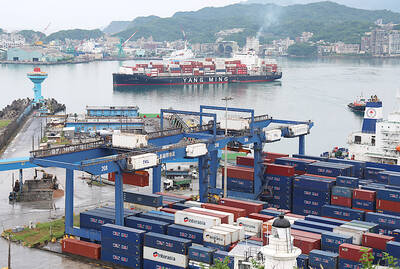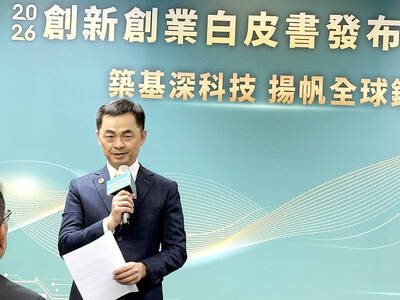Taiwan may spend more than NT$100 billion (US$3 billion) during the next three years to increase wind-power capacity 10-fold and cut coal and gas imports.
"Renewable energy can help us reduce dependence on overseas resources," Wang Yunn-ming (王運銘), deputy director general of the energy bureau, said in an interview.
Wind may help curb use of coal and natural gas, which currently each fuel about a third of Taiwan's power generators. The target of constructing turbines with a capacity of 2,159 megawatts compared with 217.2 megawatts now may prove over-ambitious, an economist at the Academia Sinica, Liang Chi-yuan (梁啟源), said.
"There's a big question mark over whether Taiwan can build so many wind turbines," Liang said. "The best sites are already taken."
Generating electricity from wind costs about NT$1.7 for each kilowatt-hour, compared with the average of NT$1.3 in Taiwan, Wang said. State-run utility Taiwan Power Co (Taipower, 台電) pays wind turbine operators NT$2 per kilowatt-hour, he said. The nation imports all its coal and more than 90 percent of its gas needs.
"Wind power technology is the most mature among renewables, and its costs are close to those of traditional generation," he said.
The figure of more than NT$100 billion will include spending on Taiwan's first undersea electricity cables to transmit power from offshore sites as far away as the Penghu archipelago, Wang said.
Offshore turbine capacity may total 360 megawatts by 2010, according to a report from the bureau, distributed at an industry conference on Wednesday. That may eventually rise to 1,200 megawatts, Wang said.
Wind farms may account for about 5 percent of Taiwan's total installed capacity by 2010, he said. That compares with 0.4 percent as of July, according to Taipower's Web site.

CHIP RACE: Three years of overbroad export controls drove foreign competitors to pursue their own AI chips, and ‘cost US taxpayers billions of dollars,’ Nvidia said China has figured out the US strategy for allowing it to buy Nvidia Corp’s H200s and is rejecting the artificial intelligence (AI) chip in favor of domestically developed semiconductors, White House AI adviser David Sacks said, citing news reports. US President Donald Trump on Monday said that he would allow shipments of Nvidia’s H200 chips to China, part of an administration effort backed by Sacks to challenge Chinese tech champions such as Huawei Technologies Co (華為) by bringing US competition to their home market. On Friday, Sacks signaled that he was uncertain about whether that approach would work. “They’re rejecting our chips,” Sacks

Taiwan’s exports soared 56 percent year-on-year to an all-time high of US$64.05 billion last month, propelled by surging global demand for artificial intelligence (AI), high-performance computing and cloud service infrastructure, the Ministry of Finance said yesterday. Department of Statistics Director-General Beatrice Tsai (蔡美娜) called the figure an unexpected upside surprise, citing a wave of technology orders from overseas customers alongside the usual year-end shopping season for technology products. Growth is likely to remain strong this month, she said, projecting a 40 percent to 45 percent expansion on an annual basis. The outperformance could prompt the Directorate-General of Budget, Accounting and

BARRIERS: Gudeng’s chairman said it was unlikely that the US could replicate Taiwan’s science parks in Arizona, given its strict immigration policies and cultural differences Gudeng Precision Industrial Co (家登), which supplies wafer pods to the world’s major semiconductor firms, yesterday said it is in no rush to set up production in the US due to high costs. The company supplies its customers through a warehouse in Arizona jointly operated by TSS Holdings Ltd (德鑫控股), a joint holding of Gudeng and 17 Taiwanese firms in the semiconductor supply chain, including specialty plastic compounds producer Nytex Composites Co (耐特) and automated material handling system supplier Symtek Automation Asia Co (迅得). While the company has long been exploring the feasibility of setting up production in the US to address

OPTION: Uber said it could provide higher pay for batch trips, if incentives for batching is not removed entirely, as the latter would force it to pass on the costs to consumers Uber Technologies Inc yesterday warned that proposed restrictions on batching orders and minimum wages could prompt a NT$20 delivery fee increase in Taiwan, as lower efficiency would drive up costs. Uber CEO Dara Khosrowshahi made the remarks yesterday during his visit to Taiwan. He is on a multileg trip to the region, which includes stops in South Korea and Japan. His visit coincided the release last month of the Ministry of Labor’s draft bill on the delivery sector, which aims to safeguard delivery workers’ rights and improve their welfare. The ministry set the minimum pay for local food delivery drivers at